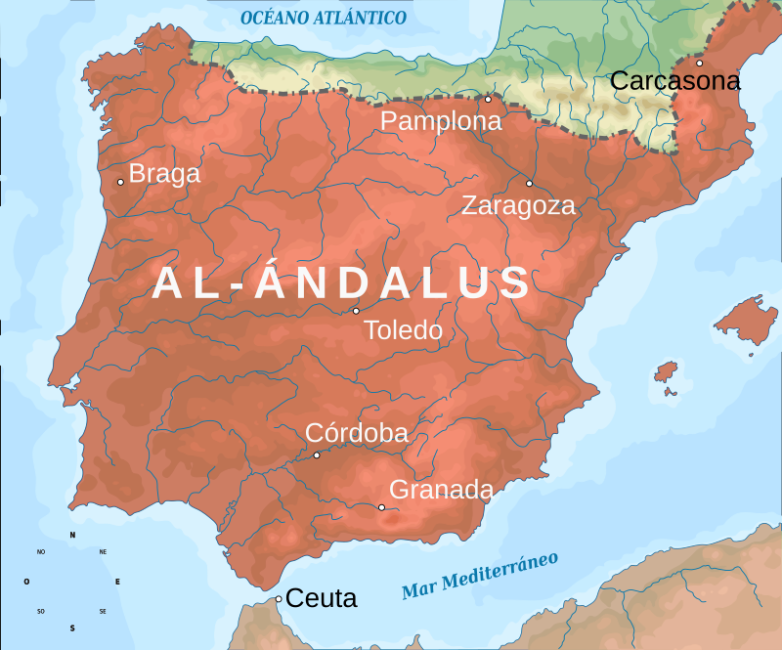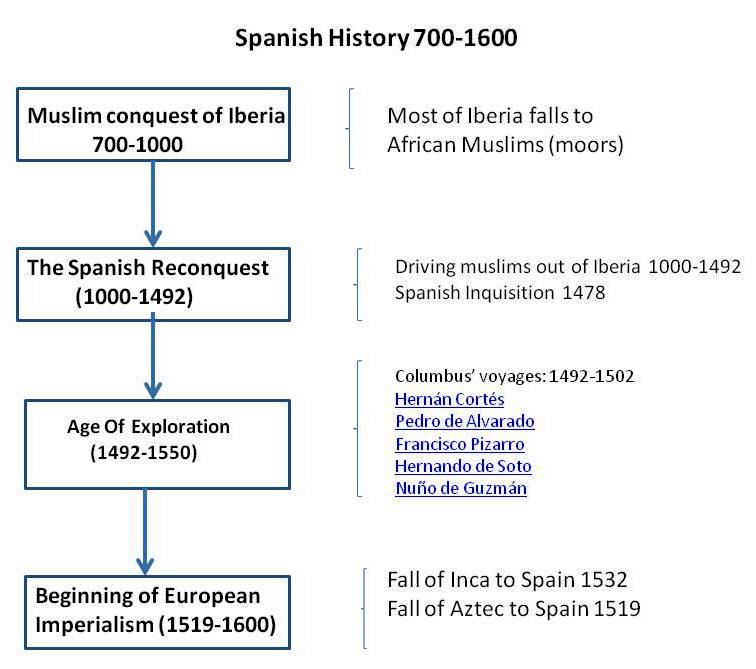History of Spain
Back To Modern Era
|
The Reconquista
|
 |
|
900 – 1492 AD
|
Muslim Conquest of Iberian Peninsula
|
Emiate of Córdoba
|
Caliphate of Córdoba
|
xxx
|
The Treaty of Granada
|
|
 |
|
 |
 |
|
|
711 – 929
|
929 – 1031
|
1031
|
xxx
|
1492
|
The Reconquista
|
Reconquest by Ferdinand I
|
xxx
|
xxx
|
Alfonso VIII
|
Isabella and Ferdinand – The Treaty of Granada
|
 |
|
 |
 |
|
|
xxx
|
xxx
|
xxx
|
1158 – 1214
|
1492 AD
|
- xxx
- Map of Iberia in 1065
- Reconquest by Alfonso VI
- The conquest of Toledo in 1085
- Book on Alfonso VI (xxxx)
- Reconquest by Alfonso VIII 1158 – 1214
- The Battle of Las Navas de Tolosa July 1212
- Defeat of Muhammad al-Nasir of the Almohads significantly hastened their decline both in the Iberian Peninsula and in the Meghreb. Only Andalusia remained in Muslim control.
- Reconquest by Ferdinand III of Castile 1217-1252
- Seize of Cordoba 1236
- The siege of Jaén 1246
- Seize of Seville 1247-48
- By 1252 the Almohad empire was almost finished
- Reconquest by Isabella and Ferdinand
- Granada War 1492
 Muslim Spain or Al-Andalus under Umayyad Caliphate in 719 AD. Al-Andalus refers to the Muslim-ruled portions of Iberia (Spain and Portugal) and the tip of North Africa during the Middle Ages. Cordoba was the capital of Muslim Spain.
Muslim Spain or Al-Andalus under Umayyad Caliphate in 719 AD. Al-Andalus refers to the Muslim-ruled portions of Iberia (Spain and Portugal) and the tip of North Africa during the Middle Ages. Cordoba was the capital of Muslim Spain.
By the end of the 13th century one remained, the Granada, the rest being incorporated into the Christian states of the north.
The Castle of Almourol: An iconic medieval military monuments of the Reconquista,
The Battle of the Guadalete 711 – Roderic VS Ṭāriq ibn Ziyad (African Muslim)
Roderic was killed in the battle, along with many members of the Visigothic nobility, opening the way for the capture of the Visigothic capital of Toledo.
Seize of Toledo 711
Arabic and Berber troops under Musa ibn Nusayr had conquered Tangiers and Ceuta between 705 and 710, and commenced raids into the Visigothic kingdom in 711. Ruderic led an army to confront the raiders. He was defeated and killed in battle, apparently after being betrayed by Visigothic nobles who wished to replace him as king and did not consider the Arabs and Berbers a serious threat. Tariq, seizing the opportunity presented by the death of Ruderic and the internal divisions of the Visigothic nobles, captured Toledo, in 711 or 712
Revolt in Spain 740–743 : Fight between Arab and African Muslims (Berbers)
Abd al-Rahman I, First Emir of Cordoba 756 – 788
Abd al-Rahmān III Last Emir of Cardoba (912 – 929)
Abd al-Rahmān III First Caliph of Cardoba (929 – 961)
Hisham III of Córdoba 1026–1031 Last and 11th Caliph of Córdoba
He could not enter Córdoba until 1029 as the city was occupied by the Berber armies of the Hammudids.Although he tried to consolidate the Caliphate, the raising of taxes (to pay for mosques amongst other things) led to heavy opposition from the Muslim clerics. After the murder of his Vizier al-Hakam by a conspiracy of Cordoban Patricians, Hisham was imprisoned. He managed to escape, but died in exile in 1036 in Balaguer. After the Caliphate fell with the overthrow of Hisham III in 1031, the Caliphate’s land holdings—already much diminished from its height in power just 100 years past—devolved into a number of militarily weak but culturally advanced taifas. Examples of taifas are the Taifa of Zaragoza”, the Taifa of Tortosa, the taifas of Seville and Badajoz etc.
Septimania during Pepin´s expedition (752-759)
Spanish March
This region was established by Charlemagne in 795 as a defensive barrier between the Umayyad Moors of Al-Andalus and the Frankish Carolingian Empire (Duchy of Gascony, the Duchy of Aquitaine and Carolingian Septimania). Asturias, Spanish March and Emirate of Cordoba comprised Spain in 800 AD.
Leon-Galicia, Navarre, Asturias, Spanish March and Emirate of Cordoba comprised Spain in 900 AD
Christian cities of Castile, Navarre, Asturias, Spanish March, Barcelona in Northern Spain and Emirate of Cordoba comprised Spain in 1000 AD. Size of Emirate of Cordoba stayed pretty much the same from 720 to 1000. Zaragoza was the north-east part of the Emirate, right below the Spanish March.
Hisham III of Córdoba 1026–1031 Last and 11th Caliph of Córdoba
He could not enter Córdoba until 1029 as the city was occupied by the Berber armies of the Hammudids.Although he tried to consolidate the Caliphate, the raising of taxes (to pay for mosques amongst other things) led to heavy opposition from the Muslim clerics. After the murder of his Vizier al-Hakam by a conspiracy of Cordoban Patricians, Hisham was imprisoned. He managed to escape, but died in exile in 1036 in Balaguer. After the Caliphate fell with the overthrow of Hisham III in 1031, the Caliphate’s land holdings—already much diminished from its height in power just 100 years past—devolved into a number of militarily weak but culturally advanced taifas.
1050: Christian states in Northern Spain: León -Castile, Navarre, Aragon and Barcelona and Muslim Emirate of Cordoba
1120: Almoravid Empire based in present day Morocco in Spain – The Almoravids were crucial in preventing the fall of Al-Andalus to the Iberian Christian kingdoms, when they decisively defeated a coalition of the Castilian and Aragonese armies at the Battle of Sagrajas in 1086.
1170: Almohad Caliphate
1250: Spain is all Christian except for Granada all the way down above the Strait of Gibraltar. The Christian Kingdoms are Castile, Navarre, Aragon and Portugal. The Reconquista is almost over at this stage. The three kingdoms Castile, Navarre, Aragon would unite around 1450 to give birth to modern Spain.

| 700-1000 |
|
| 1212 | The battle of Las Navas de Tolosa:The Christian Kingdoms of Leon, Castills, Navarra and Aragon recover all Iberian Peninsula from the Muslims except Granada |
| 1478 | The Spanish Inquisition (different from Reconquest) |
| 1482-92 | The Granada War: 1. 1487: Siege of Málaga 2. 1488: Fall of Almuñécar, Salobreña and Almería were taken by by Isabella I and Ferdinand II 3. 1491: Granada was the only Muslim-governed city in Iberia. 4. 1492: On 2nd January, Muhammad XII, Nasrid dynasty’s Emirate of Granada surrenders to Ferdinand and Isabella. Christopher Columbus seems to have been present; he refers to the surrender. Muslim rule that started in 711 in Iberian peninsula comes to an end. Isabella starts the Age of exploration. |
Reconquista, English Reconquest, in medieval Spain and Portugal, is a series of campaigns by Christian states to recapture territory from the (African) Muslims (Moors), who had occupied most of the Iberian Peninsula in the early 8th century.
Starting with 700 AD, the Iberian Peninsula witnessed the invasion of the peninsula by the Moors armies from Northern Africa in 710 and its subsequent expulsion at the end of the Reconquest, around 1500.
The battle of Las Navas de Tolosa in 1212 symbolizes the final triumph of the Castilian kingdom aka Spain and the Catholic Church over the Muslim South. The Christian Kingdoms recovered almost all the territory except Cardoba in 1212.

Figure 1
Figure 1 shows the Caliphate of Cordoba around 1000, at the apogee of Al-Mansur, the de facto ruler of the Moors of Al-Andalus in the late 10th to early 11th centuries. It is apparent from the map that almost the entire territory of the peninsula was under Moorish domain in that year.
In the year 722, soon after the beginning of the Moorish occupation of the Iberian Peninsula, a noble named Pelayo led the first phase of what has been known as the Spanish Reconquest, a military campaign to expel the Moors and repopulate Iberian towns and cities with Christian population.
In his excellent account of the Reconquest, O’Callaghan (2003) argues that around the mid-11th century the Spanish Reconquest became a Christian crusade that was quite explicitly sponsored by the pope. Pope Alexander II (1062-1073) and most of his successors up until the 14th century encouraged European Christian knights to carry out expeditions into Spain and offered the same spiritual rewards that were offered to those who would fight in the crusades in Jerusalem: relief from penance and remission of sins.
A historical reference: Clash between Umayyad caliphate in Spain and Abbasid Caliphate in Baghdad
Some historians credit Al-Mansur with starting the Abbasid–Carolingian alliance. In fact, it was the first Carolingian king Pippin III who initiated a new era of Franconian diplomacy by sending diplomatic envoys to Al-Mansur’s Baghdad court in 765. It is probable that Pippin III sought an alliance with Al-Mansur against their common enemies, the Emirate of Córdoba. In 768 the envoys of Pippin III returned to Francia along with caliph Al-Mansur’s ambassadors. Pippin III received Al-Mansur’s delegation in Aquitaine and gifts were exchanged as a sign of the new alliance. This alliance was solidified when between 797 and 807 king Charlemagne and caliph Harun Al-Rashid established embassies.
Reforms in Castile
Marriage of Isabella I of Castile and Ferdinand II of Aragon on 1469 laid the foundations for the kingdom of Spain. They didn’t ascend to their respective thrones until 1474 and 1479 respectively. At this point, Granada was the only kingdom ruled by a Muslim (Sultan Muhammad XII). The rest of the Kingdoms — Aragon, Castille, Navarre and Portugal — were all Christians. The Christian Kingdom became united to get rid of the last Muslim ruler in the Iberian Peninsula: Sultan Muhammad XII.
1.4 The Conquest of Granada

After the Granada War ended 2 January 1492, the old Muslim-ruled Kingdom of Granada became part of the Crown of Castile. On that day, the last Muslim leader, Muhammad XII, gave up complete control of Granada, to Ferdinand and Isabella [See the surrender]. With that, muslims completely disappeared from the Iberian Peninsula after nearly 700 years.